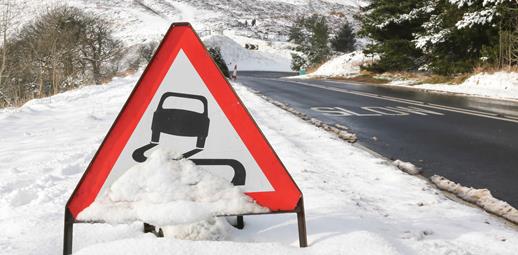
Driving in ice can be dangerous and many people choose to stay at home until the weather’s thawed out. But if you do need to drive on icy roads, here are some steps you can take to stay safe.
Easy as Hack
If your car thermometer is close to zero, there’s a good chance the roads are icy and you may encounter black ice on the road.
At a glance
- Check the weather forecast and transport news before you travel
- Learn how to safely handle your vehicle on icy roads
- To avoid ice driving altogether, reschedule your journey for hours when the sun is shining
1. Be prepared for icy conditions
Prepare yourself and your car in advance for ice driving. In winter, it’s particularly important to make sure your car is well maintained, with tyres in good condition and windscreen wash topped up. We also recommend having some essentials with you in the car, such as an ice scraper, a torch, a blanket, warm clothes and a fully charged phone.
Don’t miss: Our full list of winter car maintenance tips.
2. Leave plenty of time
Allow plenty of time for potential hold-ups caused by icy conditions. Check the weather forecast and local transport news so you can plan your route carefully.
Before you set off, make time to clear any ice completely from your windscreens and all car windows. It's not safe to only clear a small hole in your icy windscreen and hope the rest will defrost as you drive. In fact, the Highway Code states that “You MUST be able to see, so clear all snow and ice from all your windows”.
3. Take it easy
If you’re driving in ice, slow down and drive cautiously, especially when going around corners or if your view of the road ahead is obscured. Keep your speed low if you are on the motorway too. Driving slowly means you have more time to react to hazards, including black ice on the road, vulnerable road users or another vehicle that’s in trouble.
Keep a large gap between your car and the vehicle in front of you. Did you know that stopping distances can increase ten-fold in icy conditions? This could mean a braking distance of a whooping 200+ metres in a 30-mile-per-hour zone.
Check this out: Driving in fog: when to use fog lights
4. Watch out for hail
Hail often occurs when it’s very cold and icy outside and this can bring driving visibility close to zero.
If it’s safe to pull over and wait for the hail to stop, do so, but don’t get out of the car. If possible, face your front windscreen in the direction of the hail as it’s stronger than your car windows.
5. Watch out for black ice
Ice, unlike snow, can be tricky to spot. This is especially true for the dreaded black ice, a thin layer of ice on the road that is transparent – it’s the colour of the road underneath, which makes it look black. Quiet roads are more often affected by black ice than busy roads.
To spot black ice on the road, keep an eye out for glossy, wet-looking tarmac, and be particularly careful if you see other drivers sliding.
Since black ice on the roads is so tricky to spot – especially in shaded areas or in the dark – Uniroyal Tyres recommends using your car thermometer as a guide. If it’s close to freezing, you’ll need to be extra careful.
Read this: 10 tips to prepare your car for the cold weather
What to do if you slide on icy roads
If you encounter icy patches on the road and your car skids, it can be very frightening. Once your car has started to slide, it’s impossible to correct the slide using steering alone.
If you suspect ice up ahead, pull over if it’s safe to do so. If you’re not able to pull over, don’t panic. Drive at a cautious speed so it’s easier to correct a slide and stay safe.
Other tips to help you stay in control when ice driving include:
- Try and anticipate the need to stop or slow down, so you can brake gently
- Avoid harsh braking or slamming your foot down. Carry out manoeuvres extra slowly
- Use the highest gear possible to avoid wheel spin
- But if you’re driving downhill, stick to a lower gear to stay in control
- If your car starts to slide, resist the urge to brake hard as this could make the slide worse
- Ease off the accelerator and steer slightly in the direction of the skid until you gain control
- Look where you want the car to go
- Don’t oversteer though, also known as over-correcting
- Don’t take your hands off the steering wheel
- Always keep your seatbelt on
Should you help other drivers stuck on icy roads?
Generally, no. It can cause more danger and lead to collisions if you stop your car to help another driver in icy road conditions.
To read more about road safety go to Solved.
Original article written 24th September 2021, updated 28th October 2023
Protect yourself driving in icy conditions
Ageas car insurance is Defaqto 5 Star rated, with add on breakdown cover powered by the RAC. So you know you’re covered whatever the weather.
You can find out more about our car insurance here.


